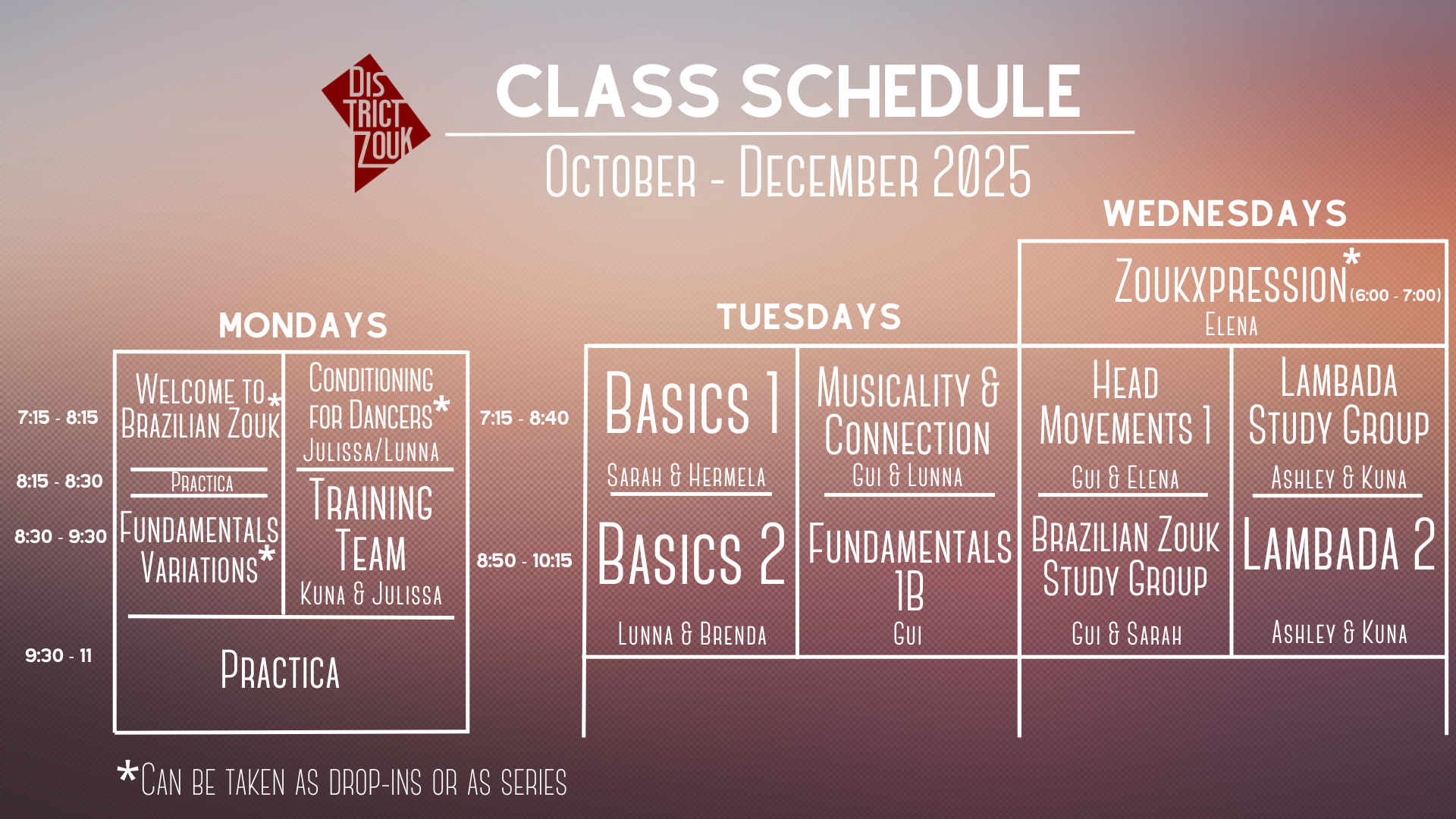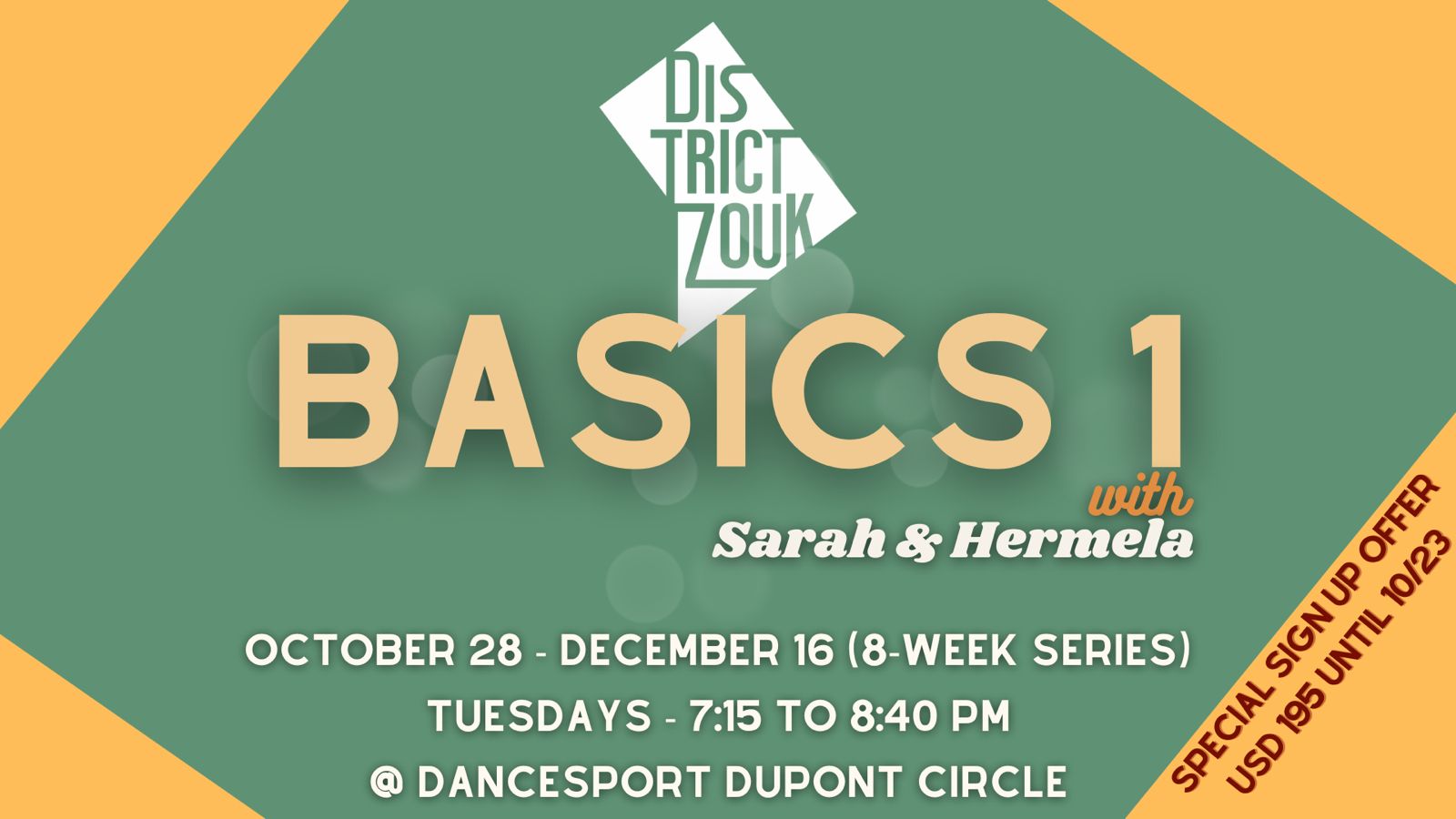Get Your Tickets
Sign up now to reserve your spot
Our last cycle of progressive classes of the year is on.

From October 20 to December 18, we're offering our last cycle of progressive classes of 2025.
This cycle brings:
- 5 curriculum courses:
- 3 special courses:
- 2 study group courses:
You can learn more about our curriculum and special classes below.
SCHEDULE - October 20 to December 17
Sign up to save your spot!
We now offer two different options to register for our 8-week series classes:
Also new this cycle: our series classes now include admission to our Monday practicas, so that's included in your ticket.
Our one-hour classes have different pricing:
Discounts apply if you register for multiple courses together or retake a class:
If you're a full-time student or otherwise need financial assistance, contact us via email and we can discuss your options.

Our Basics 1 series is the best way to start learning Brazilian zouk. It includes the most important basics so you can build a good foundation.
We've pushed back the first class of this series so it will begin on October 28. Registration options are:
In addition, if you're a federal employee or contractor impacted by the government shutdown, we're offering a 75% discount on our Basics 1 series. You can sign up with code Shutdown to take advantage of this.

DZ's Code of Conduct helps us promote a safer and welcoming environment to the community.

After years of teaching continuous progressive classes, organizing socials, workshops, and observing social dance dynamics in our community, we adapt and adjust the ways, the speed, and the order in which we teach Brazilian Zouk fundamentals.
Our current curriculum is then the result of continuous improvement, aiming to provide our students with the tools to connect all the Brazilian Zouk pieces.
Our main goal at District Zouk is to provide the tools to help you become a comfortable and versatile social dancer.
Within the time we have during each cycle - 85 minutes per week for 8 weeks - we focus on teaching the essential skills to dance Brazilian Zouk. On top of such skills, we build the fundamental patterns and other of the dance's signature movements.
We also build our curriculum to develop your social dancing skills beyond the knowledge of the movements, providing time to dance and practice in class with the guidance of our instructors and assistants.
Our courses and how to progress

Our Core Brazilian Zouk Curriculum is made of 11 progressive courses:
- Basics Courses: Basics 1, 2, and 3
- Fundamentals Courses: Fundamentals 1A, 1B, 1C and 2
- Foundations Head Movements: Head Movements 1, 2A and 2B
- Improvement Courses: Study Group
Taken consecutively, from Basics 1 to Head Movements 2A or B, our curriculum covers one's first 18 or so months into Brazilian Zouk.
Each of these courses covers a set of essential skills, fundamental patterns, body movements, transitions, and general lead-and-follow principles.
The Study Group works differently from the previous courses, as it doesn't have a set syllabus. That means that each new cycle we'll be studying a different topic at the Study Group.
Moving from one course to another is simple. Each course and group of courses has a set of essential skills students need to embody to move on to the next. Our instructors verify it by the end of each course or through our Assessments that happen between cycles.
Fundamentals 1A, 1B, and 1C as well as Head Movements 2A and 2B, can be taken in any order as they present similar difficulty levels.
To progress to Fundamentals 2, the student must have completed Fundamentals 1A, 1B, and 1C. To progress to the Study Group, the student must have completed Head Movements 2A and 2B. Even upon completion of the above courses, the referred progressions also depend on approval from the Instructor.
Joining any of the courses above Basics 1 requires an assessment from our instructors.
Our Lambada Curriculum follows a similar progression:
- Lambada 1 is the start and requires students to be at least at the Fundamentals level in Brazilian zouk
- Lambada 2, 3 and 4 progress from there
- Improvement Courses: Study Group
Complementing our curriculum with fun and interesting topics
Every cycle we offer 1-2 Special Topics courses.
These courses complement our curriculum by zooming into specific aspects of the dance.
For our upcoming October-December cycle, we have:
- Conditioning for Dancers
- Musicality & Connection
- Zoukxpression
Since these courses are not in the regular flow of our curriculum progression, please mind their prerequisites. You'll find them in the descriptions below.
Each course is 8 weeks long, with one 85 minutes class per week. We strongly encourage students to practice outside of class and, most importantly come to Practicas and Socials given the limited time we have together.
Basics 1 to 3, Fundamentals 2, and Head Movements 1, 2A, and 2B all present a more fixed syllabus.
Fundamentals 1A, 1B, and 1C can vary from cycle to cycle. These are courses designed to present more options and variations of the content developed during our Basics Courses. Therefore, different options will be presented depending on each group of students in each cycle.
We strongly encourage you to take more than one course at the same time when possible.
On a case-by-case basis, students can take 2 or more classes in our curriculum or a combination of those with Special Topics.
If you’re brand new to Brazilian Zouk, start at our Welcome to Zouk Monday class or Basics 1.
If you've been dancing Brazilian Zouk already let us know so we can set up an individual assessment. With the assessment, we'll be able to verify what course(s) will work best for you.
At each course, we cover several aspects of Brazilian Zouk, focusing first on learning the dance's essential skills
Learn about and review your foundations and basics here.
Our Basics 1 Course covers the first set of essential skills and fundamental patterns in Brazilian Zouk.
In terms of essential skills, at this level we cover:
- Basic timing and rhythm,
- Leading and following with the body, and
- Basic Floorcraft with understanding of the tracks in Brazilian Zouk.
In terms of fundamental patterns, we'll cover:
- Basics (Basic on the Spot, Side Basic, and Linear Basic),
- Viradinha,
- Send Away,
- Lateral,
- first version of Simple Turn*,
- Simple side-to-side body undulations, and
- combining everything.
TO PROGRESS TO BASICS 2, THE STUDENTS NEEDS TO, AT LEAST:
- be able to stay in the timing,
- get in and out of lateral and lead and follow with their entire body not just with the arms,
- Leader: walk around the track of the follower,
- Follower: stay on their track.
*Brazilian Zouk has several variations of the 'Giro Simples', the Simple or Single Turn. In Basics 1, we cover the Simple Turn coming from the Linear Basic.
Our second Basics course expand what was covered on Basics 1 and introduces new skills and patterns
During our Basics 2 course, we'll cover the following essential skills:
- Basic direction changes in the Linear Basic
- Slowing down the dance,
- Leading and following with the body,
- Understanding and playing with the tracks.
When it comes to the fundamental patterns, the above skills will help us build:
- Elástico and variations,
- Vira-Lateral
- Lunge,
- second version of Simple Turn**
- one version of Soltinho***, and
- Undulations
TO PROGRESS TO BASICS 3, THE STUDENT NEEDS TO, AT LEAST:
- same as Basics 1
- be able to transition between the movements learned in Basics 1 and Basics 2
**Brazilian Zouk has different variations of 'Giro Simples', the Simple or Single Turn. In Basics 2, we cover the Simple Turn coming from the Lunge.
***Brazilian Zouk has different variations of 'Soltinho'. In Basics 2, we cover Soltinho without the leader's turn.
Completing our Basics courses, Basics 3 brings the final set of fundamentals patterns and techniques in Brazilian Zouk.
During our Basics 3 course, we'll continue developing the essential skills we've started in the previous Basics.
When it comes to fundamental patterns, Basics 3 will bring:
- Arm wrappings - Yo-yo and Cuddles
- Bonus
- Lateral Opening
- Traveling Simple Turn
- Soltinho****
- On top of everything, we'll work on the transitions between everything that was learned in this and previous Basics courses.
PROGRESSION TO THE FUNDAMENTALS COURSES:
To progress to Fundamentals 1A or 1B, the student will need to:
- be able to stay on timing consistently and slow it down,
- change directions in the basics,
- be able to combine the fundamental patterns, especially Lateral, Elástico, Bonus, Simple Turn, and Soltinho.
For the leaders
- have ease in navigating the tracks and executing the related fundamentals
For the followers
- maintain consistency in the lateral footwork and awareness of directions in open position
**** Soltinho where the leader also turns
If, by the end of Basics 3, the student cannot keep the timing, they will not be able to progress into the Fundamentals Courses.
Once all Basics Courses are completed, the student can start our Fundamentals Courses.
This progression is not automatic. The student needs approval from our instructors either in class or through an assessment.
The Fundamentals courses are designed for horizontal progression, where we'll have time to play with everything we've learned so far, variations, and important aspects of musicality.
There are 3 courses: Fundamentals 1A, 1B and 2.
Fundamentals 1A and 1B are similar in difficulty and can be taken in any order.
Fundamentals 2 requires the student to have taken both Fundamentals 1A and 1B.
Combine everything, more musicality, learn new vocabulary
Fundamentals 1A, 1B, and 1C focus on getting everything we learned in our Basics Courses, combining the content, and bringing new and exciting variations that will enrich the dance.
It'll also be an opportunity to refine our essential skills and learn new ways of executing the movements we learned in their basic form.
Each course will present a new fundamental, variations of the fundamental patterns, direction changes, and explore a different aspect of musicality and play, as well as a different family of body movements.
Check out the topics below.
Abertura
Viradinha
Bônus
Body Movements - Undulations
Musicality - Playing with rhythm
Balanço
Soltinho
Yo-yo and Cuddle
Simple Turn
Musicality - Understanding the structure of the song
Body Movements - Isolations
Viradinha
Soltinho
Bonus
Avião
Elásticos
Musicality - Dancing to Rhythm
This course brings our last set of classic Brazilian Zouk Fundamentals, and what we consider the most challenging ones.
S (esse)
Gostosinho
Pião
Raul
Cambre
After our Fundamentals Courses, the student can move to our Head Movement Courses, where we will study the foundations and principles of Brazilian Zouk's head movements.
Our Head Movement courses have the goal to provide students with the technique to a safe and comfortable head movements. Therefore, we'll prioritize practice time in class with Instructors and Assistants.
Progressing from the Fundamentals to the Head Movement Courses is not automatic. The student needs approval from our instructors either in class or through an assessment.
Here we cover the basics of head movements in a safe and structured manner. In this course, we'll approach:
Intro to Active vs Passive Head Movement
Front and sideways Unlock and Release
Balão Apagado
Entrances and Exits for Balão Apagado
After learning the Balão Apagado (circular head motion) on Head Movements 1, we continue with learning the second foundational head motion and more:
Frango Assado in close hold
Transition between Balão Apagado and Frango Assado
Active and passive head movements entrances and exits
Chicote
This course comes after Head Movements 1, and can be taken before or after Head Movements 2A.
Frango Assado in open hold
Side chicote
Active and passive head movements entrances and exits
The study group is for students who have successfully completed our head movement courses and want to continue training. It will explore ways to combine and improve everything we've learned, including fundamentals and head movements.
Combining all fundamentals, head movements and exploring variations
Deeper study of musicality for leaders and followers
Studying more complex patterns
Deepening mastery of foundations
We're offering this special class series from October-December
As the name suggests, in this new course with Gui and Lunna we’ll explore the vast helm of musicality with a focus on how to effectively communicate and exchange with your partner through the physical connection. We’ll use footwork and body movements to play with rhythm, melody, and vibe, and study the principles behind creating a comfortable connection that can lead and follow the dynamic changes that musicality can bring. The topics relating to musicality and those relating to connection will be approached interchangeably, one supporting the other. Come explore these concepts with us to have even more fun and comfort in your dancing!
Prerequisites: students must have completed at least one Fundamentals 1 (Fundamentals 1A, 1B or 1C) or last cycle’s Body Movements course (attended at least 5 classes)
The Well-Rounded Dancer: Conditioning Class
This 1-hour workout is designed specifically for zouk and lambada dancers, and open to anyone who wants to build strength, mobility, and control to support their dancing. Using only your bodyweight, we’ll explore a fusion of ballet fundamentals, Horton technique, and functional conditioning. Expect core work, balance challenges, turns, and mobility drills that will not only strengthen your body but also make your dancing feel lighter, more fluid, and more grounded. Whether you’re looking to enhance your posture, improve your stamina, or refine the way your body supports partnerwork, this class will give you the tools to move with more freedom, inner strength, and ease on the dance floor.
We recommend that you bring a yoga mat and socks for floor and across-the-floor exercises.
Find your own expression in this new technique class.
On Wednesdays, come join us for an hour-long follow-along class with Elena!
We’ll activate and explore the “zouk body” with different combinations and patterns of basic steps, as well as practicing styling options, musicality, and expression. Elena will guide you through stretching and strengthening exercises to increase mobility so that all movements become easier and more accessible!
Prerequisites: Open to anyone who has completed Basics 2 and above.
We also teach Lambada! These courses rotate in what we offer each cycle.
Brazilian zouk came from lambada, and the two dances continue to influence each other a lot today. The energy and musicality of lambada is joyful and infectious. Understanding it will help build your awareness of timing, adaptability, and possibilities in your dancing, both for Brazilian zouk and lambada.
Lambada 1
Learn the most important foundations of lambada, including the timing, basic steps, and structures. This course covers soltinho, double turns, chicote and boneca, with a focus on wifi connection. Students will be able to use Brazilian zouk basics like bonus and viradinha within lambada and dance both connected and wifi with a partner.
Prerequisites: students should be at least at the Fundamentals level from Brazilian zouk and be comfortable with soltinho, bonus, and other basic steps.
Lambada 2
This course builds off of what was covered in Lambada 1 and introduces the next set of important techniques and variations. We focus especially on boneca, including mergulho, frango assado, and other wifi variations as well as how to lead and follow it with connection. We also cover soltinho variations in both directions, piao technique, and an introduction to circular head movement in lambada.
Prerequisites: students should be comfortable with the concepts from Lambada 1, including soltinho, chicote, double turns, and wifi boneca.
Lambada Study Group
This study group is for students who have successfully completed Lambada 1, 2, 3, and 4 and want to continue training. We'll work on combinations, transitions, musicality and expression so you can dance lambada more fully and have even more fun. Get ready to diver deeper into the world of lambada!
Prerequisites: students should be comfortable dancing and combining concepts from Lambada 1-4 on typical lambada timing (on 1), including soltinho (both directions), chicote, double turns (both directions), boneca, desprezada, bonus, frango assado, piao, cambre, and circular head movements.